Synergistic Research – Frequency Equalizer Carbon with ATM Tuning Module plus High-Frequency Transducers (HFT) by Bill Wells
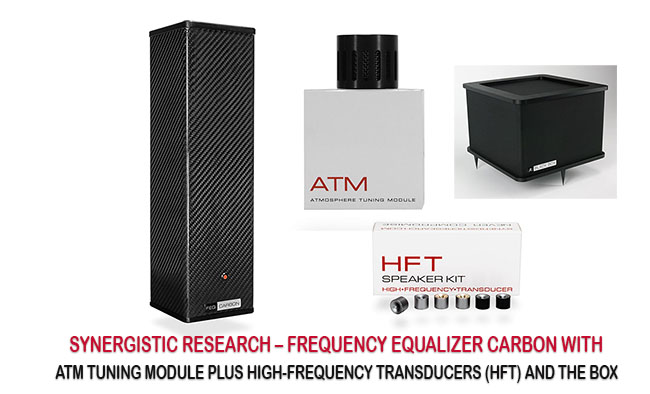
 Before starting this particular product review, just to let you know, over many years (OK decades – but who’s counting) involved in Hi-End audio (aka HiFi wonderland), I’ve had a number of conversations with lots of audiophile friends/colleagues regarding the potential sonic value of tweaks. Essentially, my basic nature is that of being a pragmatic realist and someone who tends to stick to the tried-and-true approach to improving the sound in my high-end audio system. In fact, for the most part – I’ve conveniently, perhaps stubbornly, resisted the temptation of pursuing various wild and often exaggerated claims of incredible and/or remarkable improvements in the sound of someone’s system and from just making minor changes here and there (i.e., tweaks).
Before starting this particular product review, just to let you know, over many years (OK decades – but who’s counting) involved in Hi-End audio (aka HiFi wonderland), I’ve had a number of conversations with lots of audiophile friends/colleagues regarding the potential sonic value of tweaks. Essentially, my basic nature is that of being a pragmatic realist and someone who tends to stick to the tried-and-true approach to improving the sound in my high-end audio system. In fact, for the most part – I’ve conveniently, perhaps stubbornly, resisted the temptation of pursuing various wild and often exaggerated claims of incredible and/or remarkable improvements in the sound of someone’s system and from just making minor changes here and there (i.e., tweaks).
So as things would have it, some time ago, I somehow found myself in one of those magical and compelling demonstrations hosted by Ted Denny, SR’s president and head guru of innovation and technology. For me, the experience was quite interesting, intriguing, and equally convincing. Effectively, Denny demonstrated how various products in his company’s line could address a variety of sonic issues negatively impacting typical home listening environments—ranging from all the way of opening up the sound stage with enhanced dimensionality and improved focus to augmenting low-frequency reproduction, lowering noise and any number of other sonic improvements/enhancements. Again, being somewhat reluctant to sometimes even accepting what was obvious, my journey for auditioning, evaluating, and eventually using some of these products began.
As a result of this journey, I’ve had the good fortune of being able to audition, critically evaluate and assess the effect(s) of various products from Synergistic Research (SR) in my reference system. Previously I’ve written reviews in this publication on several products from this company ranging from power conditioners and their power cords, speaker, and digital cables. In each instance, these experiences have often resulted in unexpected and often surprising discoveries of musical treasures buried in the music that was unheard of prior to installing the SR equipment. Sometimes the change has been subtle and not something immediately noticeable. Also, the overall cumulative impact of these subtle differences has resulted in profoundly enhanced musical enjoyment.
Newly Updated and Improved Frequency Equalizer with ATM Carbon Tuning Devices = Big Surprise & A Definite “Oh My!!!”
Not long ago, I received a call from Andy Wiederspahn, SR VP, who let me know that the FEQ unit currently in my system had been upgraded and if I was possibly interested in auditioning their new and improved unit. At the time of our conversation, this unit was undergoing final listening tests at the factory. Judging from the enthusiasm in his voice regarding this product – it quickly became contagious. Also, I was eager to get started knowing that replacing this device would be a straightforward process of simply swapping out the older original unit for the newer updated one. Beyond that, since I was already quite accustomed to the improvement rendered in my system by the original FEQ – I was anxious to hear this newer product. What I wasn’t prepared to experience was something that literally caught me totally off guard and quickly dispelled any notion that the newer unit was indeed better.
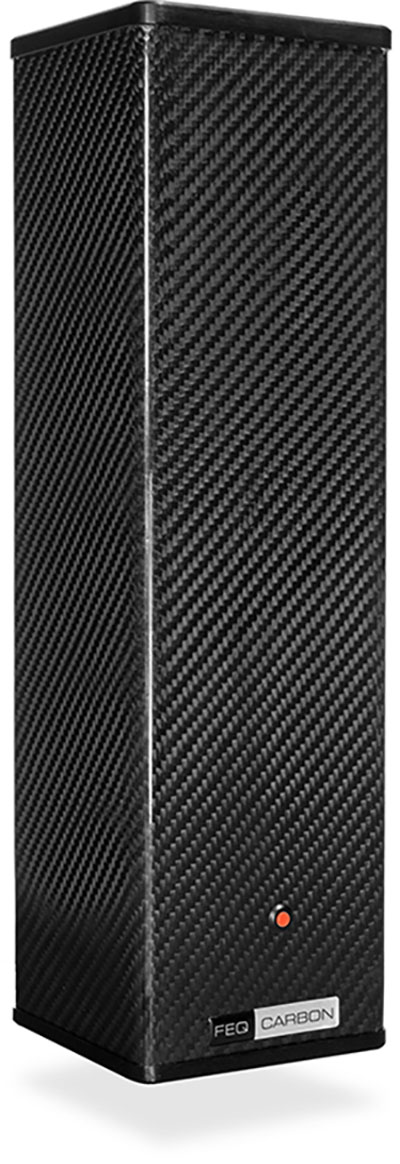
 According to information provided by SR, as well as conversations with Wiederspahn, it’s recommended that after installation of the FEQ Carbon, with the improved ATM Carbon Tuning device, to wait for a short period as the unit settles in and acclimates to the room environment in which it’s placed. Also, according to the SR website – the FEQ is a single channel ultra-low frequency pulse generator that acts as a low-frequency dither to overpower the ambient RFI and EMI fields in your listening room. This newer model improves upon the original unit and the improved FEQ X4. For additional technical description – I suggest you refer to the SR website.
According to information provided by SR, as well as conversations with Wiederspahn, it’s recommended that after installation of the FEQ Carbon, with the improved ATM Carbon Tuning device, to wait for a short period as the unit settles in and acclimates to the room environment in which it’s placed. Also, according to the SR website – the FEQ is a single channel ultra-low frequency pulse generator that acts as a low-frequency dither to overpower the ambient RFI and EMI fields in your listening room. This newer model improves upon the original unit and the improved FEQ X4. For additional technical description – I suggest you refer to the SR website.
Not much to this installation process – simply attach the power supply to the main unit, then plug this into a nearby AC outlet and flip the switch to the on position. The placement was optional, with the preferred location midway between the speakers and also slightly to the back and minimally three inches or so from the back wall. In my case, due to the placement of my equipment rack along with various power cords and speaker cables dressed along the backside – I initially placed the FEQ between the left side speaker and my equipment rack and also near the rear wall. Being anxious to check this out and after a fairly short period of time for the unit in my system, without critical listening, the change was readily apparent and in a very pleasing way. The sound took on an enhanced wholeness, with the bass becoming more evident – not deeper or more prominent, simply fuller, richer, and with improved impact.
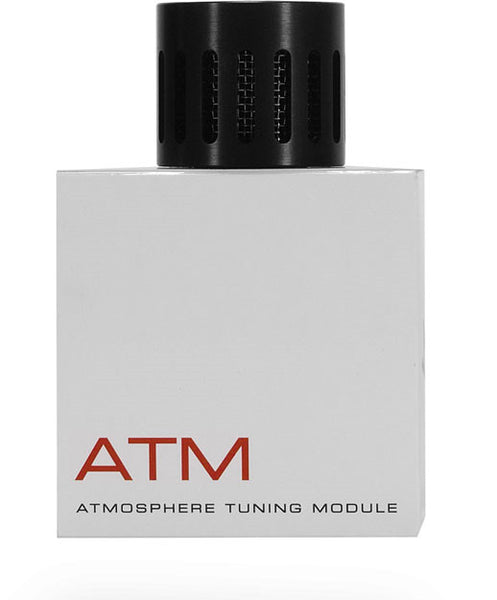
 Being satisfied with this initial reaction, I decided to follow Wiederspahn’s advice and provide the unit with more time to settle in. Essentially, I left the room and, due to a hectic day, didn’t return until later that evening. When I finally got back to my listening room, immediately and without question, the newer FEQ Carbon, with its companion ATM tuning module, quickly let me know its presence and, in a very good way. Clearly, the difference (i.e., improvement) between the original unit was anything but subtle. In fact, it was striking and caught me quite off guard. First and foremost, the newer FEQ Carbon device simply helped to saturate the entire sound field of my listening room more completely.
Being satisfied with this initial reaction, I decided to follow Wiederspahn’s advice and provide the unit with more time to settle in. Essentially, I left the room and, due to a hectic day, didn’t return until later that evening. When I finally got back to my listening room, immediately and without question, the newer FEQ Carbon, with its companion ATM tuning module, quickly let me know its presence and, in a very good way. Clearly, the difference (i.e., improvement) between the original unit was anything but subtle. In fact, it was striking and caught me quite off guard. First and foremost, the newer FEQ Carbon device simply helped to saturate the entire sound field of my listening room more completely.
With the newer unit in my system, this created a noticeably improved holographic sensation with enhanced openness and dimensionality. Additionally, there was a sensation that both the back and side walls of my listening room became less obvious with the music coming from a more open and expansive sound field. With these improvements, music came forth more effortlessly and naturally dynamic and poured forth from my speakers in a most convincing manner. At this point – inserting the newer FEQ Carbon was truly captivating. Also, based on this experience, for anyone currently using one of the earlier SR FEQ devices, I suggest auditioning one of these newer, upgraded units. The difference is nothing short of eye (i.e., ear) opening.
Beyond the above, there was an immediately noticeable improved organic texture to both voice and instruments. Lower frequencies became more robust, not in a negative, forward sounding, or bloated way, but with improved dynamic impact and umph. Beyond that, throughout the broad midrange – there was a greater sense of presence and also with a wonderful sense of fullness. In terms of the higher frequencies – again, everything simply opened up that allowed music to flow from a wonderful black background. Listening to Ahmad Jamal’s outstanding and highly acclaimed recording titled Blue Moon was absolutely thrilling. This style of many selections on this recording display Jamal’s signature dynamic thrust and command of the keyboard along with his superb melodic rendering. Bottom line, the new FEQ Carbon literally impacted (and enhanced) the entire frequency spectrum and in a most enjoyably musical manner. At this point, I felt that the level of improvement from this upgraded unit was well beyond anything that I would have imagined.
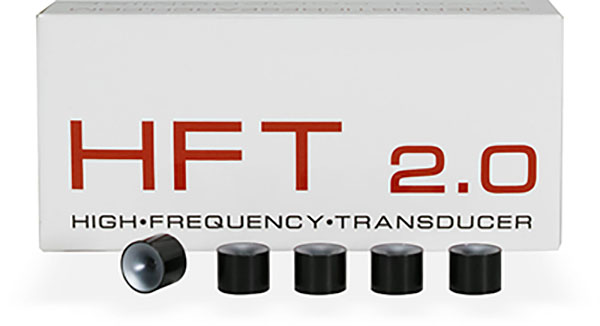
Beyond FEQ and Moving to HFTs – Getting Started and Patience Required
 Installation of the High-Frequency Transducer (HFT) devices took a bit of time first to review the instructions provided. Fortunately, the process was pretty straightforward and not at all complicated. I should emphasize and let everyone know that my listening area isn’t a totally dedicated/ isolated room (i.e., man cave) with lots of acoustic treatment. In fact, the only room treatment to speak of is a pair of Shakti Halographs in the corners behind my speakers. That’s it. I believe this is important since anyone reading this review should know that my observations are based on extensive listening in a typical room with normal dimensions for width and height. I am also blessed with my room opening up immediately past the primary listening area.
Installation of the High-Frequency Transducer (HFT) devices took a bit of time first to review the instructions provided. Fortunately, the process was pretty straightforward and not at all complicated. I should emphasize and let everyone know that my listening area isn’t a totally dedicated/ isolated room (i.e., man cave) with lots of acoustic treatment. In fact, the only room treatment to speak of is a pair of Shakti Halographs in the corners behind my speakers. That’s it. I believe this is important since anyone reading this review should know that my observations are based on extensive listening in a typical room with normal dimensions for width and height. I am also blessed with my room opening up immediately past the primary listening area.
Initially, pulling the HFTs from the small boxes, they came in simply didn’t give me high hopes for any transformation in the overall sonic performance in my listening space. Each device is relatively small (i.e., 8mm in both diameter and height) and is applied to whatever surface is being treated. The preferred method of attachment is by using BluTak. The advantage of using this adhesive material is to it allows easy removal from whatever surface is applied without potentially creating damage to that particular surface.
I need to mention that these devices vary in their designated functionality. The HFT Standard, HFT 2.0, and HFT Wide Angle devices are. Each has a specific area where they should be applied, including the back and side walls, ceiling, and even speakers. I dutifully followed the detailed, step-by-step instructions and didn’t have any issues applying these devices. The most time-consuming aspect of this project was simply wrapping my head around how these tiny devices would possibly make any real difference. After spending an evening going through the installation process and ensuring that I didn’t inadvertently take a shortcut or somehow miss an important step, it was then time to take an initial listen.
Not knowing quite what to expect from these small passive devices, I selected several recordings that quickly revealed any change in my system. Upon first listening – there was a subtle and noticeable difference with slightly enhanced dimensionality and an improved sense of openness: nothing dramatic but a positive change and overall improvement. The more I listened to familiar recordings; I noticed how things, including vocal conversations, took on a slightly different sonic character. More listening, and now my ears started to acclimate to the differences. The true acid test for me always is my wife’s perception, whose hearing is rather acute and quickly discerning. As she had done many times during my days of tinkering with my system, this time when she entered the listening room, she quickly asked…” now what have you done?” My reply – not much, why do you ask? Her immediate response was….. “things sound different, but I’m not quite sure how to describe it. The music sounds more open, relaxed, free, and alive. Yep, whatever you did – I like it.” To further demonstrate the efficacy and effectiveness of the HRTs, I played Mary Stalling’s sumptuous arrangement of “You Go To My Head” from her recording titled Manhattan Moods. Clearly – we both heard the same wonderful effect and simply enjoyed the music even more than before. In fact, there was no need to become overly analytical at this point. Simply acknowledge that the HFTs effectively did their thing and achieved their stated purpose. I was more than pleased and anxious to continue to the next step in the process.

Black Box
This particular product has been available for a number of years, and my interest in it has more to do with it being a part of the recommended FEQ/HRT setup. Additionally, it has been thoroughly reviewed in this publication previously, so my comments are more about my experience than any sort of detailed review. As a reminder, this device is basically a passive device that is relatively small in overall size (i.e., approximately 6′ tall and 9.5″ by 9.5″ square. According to the SR website – this device is a low-frequency resonator specifically to address bass and phase issues. Something that I discovered as I progressed with moving through this process with installing the other devices was how the overall bass performance had improved, both in quantity and quality. Based on the rather simple, uncomplicated, conservative appearance of this device – it was hard to wrap my head around how it could do anything significant in terms of further improving the bass performance of my system.
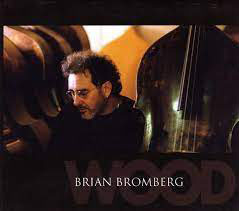 Installation is quite simple and totally straightforward, requiring only that you screw in the three long spikes supplied into the bottom of the box, two in the rear corners and one in the front middle. You then simply set the unit onto your floor with the spikes facing downward and typically piercing the carpet for a more secure connection. When mounting the device with these spikes to either hardwood floors due to potential damage, care should be taken. In terms of optimum placement – this will vary. In my case – I started with the unit directly in between my two speakers and right in front of my equipment rack. Not knowing quite what to expect – I was immediately impressed with how the already improved bass, with the FEQ Carbon in place, now took on noticeably better control and definition. Additionally, there was better synergy and blend with the rest of the bass entire range. An excellent example of this is Brian Bromberg’s recording titled Wood. Listening through the first track came through with enhanced delicacy as well as delivering Bromberg’s already outstanding bass with even better control, definition, and dynamic impact. Basically, this is a passive device and seems to provide a unique ability for tuning the bass through addressing lower frequency resonance issues in the room.
Installation is quite simple and totally straightforward, requiring only that you screw in the three long spikes supplied into the bottom of the box, two in the rear corners and one in the front middle. You then simply set the unit onto your floor with the spikes facing downward and typically piercing the carpet for a more secure connection. When mounting the device with these spikes to either hardwood floors due to potential damage, care should be taken. In terms of optimum placement – this will vary. In my case – I started with the unit directly in between my two speakers and right in front of my equipment rack. Not knowing quite what to expect – I was immediately impressed with how the already improved bass, with the FEQ Carbon in place, now took on noticeably better control and definition. Additionally, there was better synergy and blend with the rest of the bass entire range. An excellent example of this is Brian Bromberg’s recording titled Wood. Listening through the first track came through with enhanced delicacy as well as delivering Bromberg’s already outstanding bass with even better control, definition, and dynamic impact. Basically, this is a passive device and seems to provide a unique ability for tuning the bass through addressing lower frequency resonance issues in the room.
Also of note – in further reviewing the company’s instructions, there is a reference to how the Black Box works in conjunction with the HFTs. Based on my experience with having installed all of the room acoustic products in this review, it only makes sense that the additional clarity of all vocal and instrumental sounds actually took on a greater sense of clarity and realism. I’m sure you could achieve some level of improvement without the full treatment, and based on my experimentation – I would caution taking that approach. Either go the full way and be truly impressed or simply allow your room to impact the sound of your system the way it always has.
For detailed information regarding the SR Black Box, see the company’s website. Also, for a very complete and thorough review of the Black Box, check out Mike Girardi’s review here.
Conclusion
The net effect of the changes I’ve described above was readily apparent not just to me – in fact, beyond my wife, any number of visitors to our home – including several critical listeners and devoted music lovers all had very positive reactions. Each person was quick to point out how authentic and real the music sounded and was amazed at the lifelike quality of the music. Interestingly – no one ever complained about the volume being somewhat higher than they may have been accustomed to, and most simply stated how clean and effortless everything sounded. From my perspective, the music from my system is now more expressive, with music flowing more effortlessly than before. In fact – due to the very positive effects of the Synergistic Research devices covered in this review, the sound has become addictive and in ways that are uniquely different than what I typically experience with changing different electronics or cables.
Lastly, from this experience – I feel that my earlier reluctance has definitely diminished, and going forward, I will be far more receptive to give something a try when suggested. Also, in terms of these specific products – I definitely have no plans of removing them from my system, and the next call I make to Wiederspahn will simply be to arrange for an invoice sent to me. They are keepers and highly recommended.


bill wells
Specifications:
Name: Synergistic Research, Inc.
* Frequency Equalizer (FEQ), $1,695/$1,895 (110v/230v) & ATM Tuning Device, $595
* High Frequency Transducer (HFT) – $299 per 5-pack, or $75 each
* Black Box, $1,995
Address: 11208 Young River Avenue, Fountain Valley, CA 92708
Tel: 949-476-0000 or (800) 578-6489 (within the U.S.)
Website: www.synergisticresearch.com/
E-Mail: service3@synergisticresearch.com
Bill’s ASSOCIATED EQUIPMENT
Digital Software
* Asus Notebook – River Media Center 22, Windows 10
* Tidal and Qobuz – hi-rez streaming services
* Google Mesh System/Arris (router & modem)
Amplification & Digital Playback
* Bel Canto Design – Black System (ASC2 Asynchronous Stream Controller and MPS1 Mono Block Power Stream amplifiers including internal DACs
Loudspeakers
* Kharma Elegance DB7 Signature
Cabling
* A.T.&T. fiber-optic interconnects
* Cardas Clear Beyond XL power cords, speaker cables and Nautilus power strip
* Kharma Elegance & Exquisite power and speaker cables
* Silversmith Audio – Fidelium speaker cables
* Synergistic Research – Atmosphere X Euphoria speaker cables, analog and high current power cables
Accessories
* ART Q-Dampers
* Cable Towers
* Furtech NCF Nano AC receptacles
* Matrix Systems equipment rack
* Shakti Halographs
* Synergistic Research – PowerCell 12 SE UEF, FEQ X4, UEF Performance Elevators
Stereo Times Masthead
Publisher/Founder
Clement Perry
Editor
Dave Thomas
Senior Editors
Frank Alles, Mike Girardi, Russell Lichter, Terry London, Moreno Mitchell, Paul Szabady, Bill Wells, Mike Wright, and Stephen Yan,
Current Contributors
David Abramson, Tim Barrall, Dave Allison, Ron Cook, Lewis Dardick, John Hoffman, Dan Secula, Don Shaulis, Greg Simmons, Eric Teh, Greg Voth, Richard Willie, Ed Van Winkle, Rob Dockery, Richard Doron, and Daveed Turek
Site Management Clement Perry
Ad Designer: Martin Perry






Be the first to comment on: Synergistic Research – Frequency Equalizer Carbon with ATM Tuning Module plus High-Frequency Transducers (HFT) by Bill Wells